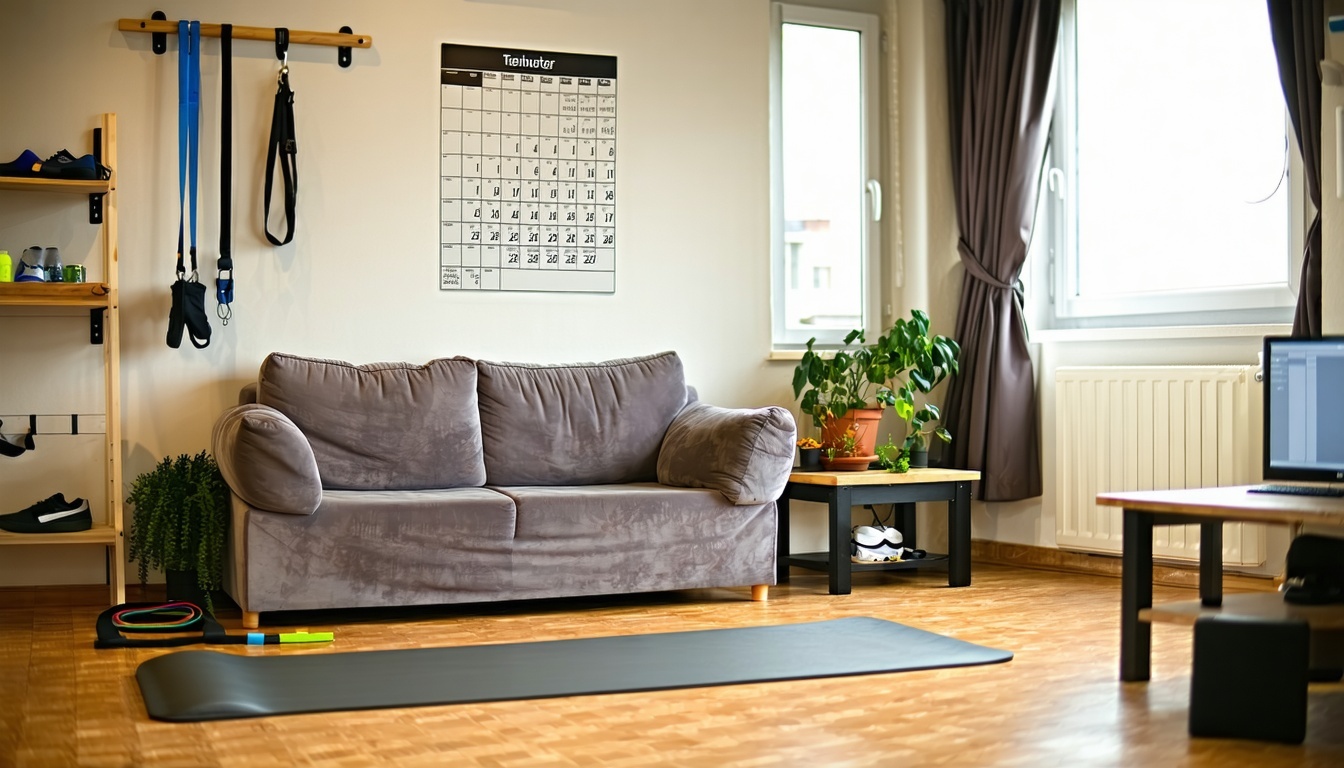How to Exercise When You're Completely Exhausted After Work
Quick Answer
When exhausted after work, start with just 2 minutes of gentle movement like stretching or slow walking. Use energy-building exercises rather than energy-draining ones. The key is beginning with micro-movements that activate your energy systems without overwhelming your already depleted state.
The Post-Work Energy Paradox
It's 6:30 PM. You've just walked through your front door after a mentally draining day, and the last thing you want to do is exercise. Your brain feels like mush, your body feels heavy, and the couch is calling your name with the irresistible promise of mindless scrolling and takeout food.
But here's the cruel irony: the very thing you least want to do—move your body—is often exactly what you need to feel human again. The problem isn't that you're lazy or lack willpower. The problem is that most exercise advice assumes you have energy to burn, when what you actually need is a way to generate energy when you feel like you have none left.
This isn't about forcing yourself through a punishing workout when you're already depleted. It's about understanding the difference between mental fatigue and physical exhaustion, and using strategic movement to transform your energy state rather than further drain it.
Understanding Post-Work Exhaustion
Mental vs. Physical Fatigue
Most post-work exhaustion is actually mental fatigue masquerading as physical tiredness. Here's how to tell the difference:
Mental Fatigue Signs:
- Feeling "tired" but not physically weak
- Difficulty concentrating or making decisions
- Emotional exhaustion or irritability
- Craving passive activities like TV or social media
- Feeling overwhelmed by simple tasks
Physical Exhaustion Signs:
- Actual muscle weakness or soreness
- Heavy, leaden feeling in your limbs
- Genuine need for sleep or rest
- Physical symptoms like headaches or body aches
- Feeling worse after any movement
The good news? Mental fatigue often responds incredibly well to gentle physical movement, while physical exhaustion requires actual rest.
The Energy Generation vs. Energy Depletion Spectrum
Not all exercise is created equal when you're tired. Some activities generate energy, while others deplete it:
Energy-Generating Activities:
- Gentle stretching and yoga
- Slow, mindful walking
- Light bodyweight movements
- Breathing exercises
- Gentle dancing or movement
Energy-Depleting Activities:
- High-intensity cardio
- Heavy weightlifting
- Competitive sports
- Long, strenuous workouts
- Any exercise that feels like punishment
The key is choosing activities from the energy-generating side when you're already depleted.
The Energy-Building Approach
The 2-Minute Commitment Strategy
When you're exhausted, the idea of a 30-60 minute workout feels impossible. But everyone can commit to 2 minutes. Here's why this works:
- Removes the pressure: 2 minutes feels manageable, not overwhelming
- Activates energy systems: Even brief movement starts circulation and releases energizing hormones
- Often leads to more: Once you start, you frequently feel good enough to continue
- Builds the habit: Consistency matters more than duration when you're building sustainable practices
The Energy Assessment Protocol
Before deciding what to do, quickly assess your energy state:
Step 1: Rate Your Energy (1-10 scale)
- 1-3: Genuinely exhausted - prioritize rest or very gentle movement
- 4-6: Mentally tired but physically capable - perfect for energy-building exercises
- 7-10: Good energy - can handle more intensive activities
Step 2: Identify the Type of Tiredness
- Stressed/overwhelmed: Focus on calming, meditative movement
- Mentally drained: Choose activities that engage your body but rest your mind
- Physically tired: Opt for gentle, restorative movements
- Emotionally exhausted: Select mood-boosting activities like dancing or walking
Step 3: Choose Your Approach
- Energy level 1-3: Gentle stretching or breathing exercises
- Energy level 4-6: Light walking, yoga, or bodyweight movements
- Energy level 7-10: Whatever type of exercise you enjoy
Gentle Exercises That Build Energy
The 2-Minute Energy Activator
When you can barely commit to anything, try this ultra-gentle sequence:
Minute 1: Gentle Stretching
- Reach your arms overhead and stretch gently
- Roll your shoulders backward 5 times
- Gently twist your torso left and right
- Take 3 deep breaths
Minute 2: Light Movement
- March in place slowly for 30 seconds
- Do 5 gentle arm circles
- Take 3 more deep breaths
That's it. If you feel slightly better, consider continuing. If not, you've still done something positive for your body.
The 5-Minute Energy Builder
If the 2-minute version felt good, try this slightly longer routine:
Minutes 1-2: Mindful Walking
- Walk slowly around your home or outside
- Focus on your breathing and the sensation of movement
- No specific pace or distance goals
Minutes 3-4: Gentle Yoga Flow
- Cat-cow stretches (4-5 repetitions)
- Child's pose (hold for 30 seconds)
- Gentle spinal twists while seated
Minute 5: Breathing and Intention
- Stand or sit comfortably
- Take 5 deep, slow breaths
- Notice how you feel compared to when you started
The 10-Minute Energy Restoration
For days when you have a bit more capacity:
Minutes 1-3: Gentle Cardio
- Slow walking (indoor or outdoor)
- Gentle marching in place
- Easy dancing to one favorite song
Minutes 4-7: Restorative Stretching
- Forward fold (standing or seated)
- Gentle backbend or chest opener
- Hip circles and leg swings
- Neck and shoulder rolls
Minutes 8-10: Mindfulness and Breathing
- Gentle meditation or breathing exercises
- Body scan to notice areas of tension
- Gratitude for your body's ability to move
The Psychology of Starting When You Don't Want To
Overcoming the Mental Resistance
The biggest barrier isn't physical—it's mental. Here are strategies to overcome the "I don't want to" feeling:
The Commitment Ladder
- "I'll just put on workout clothes" (often this alone shifts your mindset)
- "I'll just step outside/go to my exercise space"
- "I'll just do 30 seconds of movement"
- "I'll just do 2 minutes"
- "I'll see how I feel after that"
The Energy Experiment Mindset
Instead of "I have to exercise," try "I'm going to experiment with whether gentle movement makes me feel better or worse." This removes pressure and adds curiosity.
The Future Self Visualization
Ask yourself: "How will I feel in 30 minutes if I do nothing versus if I do just 2-3 minutes of gentle movement?" Usually, the answer is clear.
Dealing with the "All or Nothing" Mentality
Many people struggle because they think exercise has to be intense or long to "count." Here's how to reframe:
- Something is infinitely better than nothing: 2 minutes of movement provides real benefits
- Consistency beats intensity: Daily gentle movement trumps occasional intense workouts
- Energy building is a valid goal: Not every workout needs to be about burning calories or building strength
- Rest is also productive: Sometimes the best choice is actually to rest
Specific Strategies for Different Types of Exhaustion
When You're Mentally Drained
Mental exhaustion from work often responds well to physical movement that doesn't require mental engagement:
Best Activities:
- Walking while listening to music or podcasts
- Gentle yoga with guided videos
- Dancing to favorite songs
- Swimming or water-based activities
- Repetitive movements like cycling
Avoid:
- Complex workout routines that require thinking
- Competitive activities that demand mental focus
- New exercises that require learning
When You're Emotionally Exhausted
Emotional exhaustion needs activities that process feelings and restore emotional balance:
Best Activities:
- Walking in nature
- Gentle, flowing yoga
- Dancing or expressive movement
- Swimming or water activities
- Breathing exercises and meditation
Focus on:
- Activities that feel nurturing rather than challenging
- Movement that helps process emotions
- Exercises that connect you with your body
When You're Physically Tired
True physical fatigue requires the gentlest approach:
Best Activities:
- Gentle stretching
- Restorative yoga poses
- Slow, mindful walking
- Breathing exercises
- Light mobility work
Warning Signs to Stop:
- Feeling worse after starting
- Increased fatigue or weakness
- Any pain or discomfort
- Difficulty maintaining good form
Environmental and Practical Considerations
Creating an Exercise-Friendly Environment
When you're exhausted, even small barriers can prevent you from moving. Set yourself up for success:
Physical Environment:
- Keep workout clothes easily accessible
- Have a designated space for gentle movement
- Remove barriers like having to move furniture
- Keep yoga mats or exercise equipment visible
Mental Environment:
- Have a playlist of calming or energizing music ready
- Keep guided meditation or yoga videos bookmarked
- Set up your space to feel inviting, not intimidating
- Remove pressure by having no specific goals or expectations
Time-of-Day Considerations
Immediately After Work:
- Use the transition time before you fully "settle in" at home
- Change into comfortable clothes first
- Start with just 2-3 minutes to assess your energy
After Dinner:
- Wait at least 30 minutes after eating
- Focus on gentle, digestive-friendly movements
- Avoid intense exercise that might interfere with sleep
Before Bed:
- Choose calming, restorative activities
- Focus on stretching and breathing exercises
- Avoid energizing movements that might disrupt sleep
Building Long-Term Sustainable Habits
The Habit Formation Strategy
Building a sustainable post-work movement habit requires a different approach than traditional fitness advice:
Week 1-2: Establish the Trigger
- Focus only on putting on comfortable clothes after work
- Don't worry about actual exercise yet
- Build the routine of changing into "movement clothes"
Week 3-4: Add Micro-Movement
- After changing clothes, commit to just 1-2 minutes of gentle stretching
- Focus on consistency, not intensity or duration
- Celebrate the habit, not the workout
Week 5-8: Expand Based on Energy
- Let your energy level guide the duration and intensity
- Some days might be 2 minutes, others might be 15
- Build flexibility into your routine
Month 2+: Optimize and Adapt
- Develop different routines for different energy levels
- Add variety to prevent boredom
- Continue prioritizing consistency over intensity
Tracking Progress Without Pressure
Traditional fitness tracking can feel overwhelming when you're already exhausted. Try these gentler approaches:
Energy-Based Tracking:
- Rate your energy before and after movement (1-10 scale)
- Note which activities make you feel better or worse
- Track your mood and sleep quality
Consistency Tracking:
- Simply mark whether you did any movement, regardless of duration
- Celebrate streaks of consistency
- Don't punish yourself for missed days
Qualitative Tracking:
- Note how different types of movement affect your evening
- Track which activities help you sleep better
- Observe changes in your overall energy levels over time
When to Choose Rest Instead
Recognizing True Exhaustion
Sometimes the best choice is actually to rest. Here's when to prioritize sleep over movement:
Physical Signs:
- Genuine muscle weakness or soreness
- Feeling worse after gentle movement
- Physical symptoms like headaches or body aches
- Difficulty maintaining balance or coordination
Mental/Emotional Signs:
- Feeling overwhelmed by the idea of any movement
- Emotional distress that worsens with activity
- Inability to focus on even simple movements
- Strong intuitive feeling that you need rest
Situational Factors:
- Less than 6 hours of sleep the night before
- Illness or recovery from illness
- Extremely stressful life events
- Multiple consecutive days of poor sleep
Making Rest Productive
When you choose rest over movement, make it intentional and restorative:
- Quality rest: Choose activities that truly restore you, not just distract you
- Mindful rest: Be present with your choice to rest rather than feeling guilty
- Prepare for tomorrow: Use rest time to set yourself up for better energy the next day
- Listen to your body: Trust that sometimes rest is exactly what you need
Frequently Asked Questions
Is it okay to exercise when you're really tired?
Yes, gentle exercise can actually increase energy levels when you're mentally tired. The key is choosing the right type and intensity—focus on movement that energizes rather than exhausts. Start with just 2 minutes of gentle activity and listen to your body's response.
What's the minimum exercise that's still beneficial when exhausted?
Even 2-3 minutes of gentle movement like stretching or slow walking can improve circulation, mood, and energy levels. The key is that something is always better than nothing. Brief, gentle movement can activate your energy systems without overwhelming your depleted state.
Why do I feel more tired after work than during work?
Mental fatigue from work often feels like physical exhaustion, but they're different. Your body may actually have energy, but your mind is drained from decision-making, concentration, and stress. Gentle movement can help separate mental and physical fatigue, often revealing that you have more physical energy than you thought.
Should I force myself to exercise when I don't want to?
Don't force intense exercise, but commit to just starting with 2 minutes of gentle movement. Often the hardest part is beginning—once you start, energy naturally increases. If you feel worse after starting, stop and rest. The goal is to experiment with movement, not punish yourself.
What if I feel worse after trying to exercise when tired?
Stop immediately and rest. This usually means you chose too intense an activity or you're genuinely physically exhausted rather than just mentally tired. Try gentler movements next time, or prioritize sleep and proper rest. Your body's feedback is always the most important guide.
Related Professional Fitness Solutions
Explore more strategies for maintaining fitness with demanding schedules:
- Complete Guide to Staying Fit as a Busy Professional - Comprehensive strategies for professional fitness
- 2-Minute Morning Motivation Primer - Start your day with energy-building movement
- 15-Minute Post-Work Decompression Routine - Longer routine for processing work stress
- Minimum Effective Dose for Zero Motivation - The absolute least you can do while still getting benefits
- Seasonal Depression Workout Strategies - Exercise approaches for difficult mental health periods
Conclusion: Redefining Exercise When You're Exhausted
The fitness industry has sold us a lie: that exercise always requires energy, motivation, and intensity. But the truth is that the times when you feel least like exercising are often when gentle movement can be most transformative.
This isn't about forcing yourself through punishing workouts when you're already depleted. It's about understanding that movement can be medicine—a way to generate energy rather than drain it, to process stress rather than add to it, to reconnect with your body rather than punish it.
The goal isn't to become someone who loves working out when they're exhausted. The goal is to become someone who knows how to use gentle movement as a tool for energy restoration, stress processing, and overall well-being.
Start small. Start gentle. Start with just 2 minutes and see what happens. Your exhausted self deserves movement that feels good, not movement that feels like punishment. And sometimes, your exhausted self deserves rest—and that's okay too.
The most important thing is learning to listen to your body, trust its signals, and respond with compassion rather than force. Whether that's 2 minutes of gentle stretching or a full night's sleep, you're taking care of yourself in exactly the way you need.
Tomorrow is a new day, with new energy and new possibilities. But today, right now, you have everything you need to take one small, gentle step toward feeling better. That's enough. You're enough.





-1.jpg)